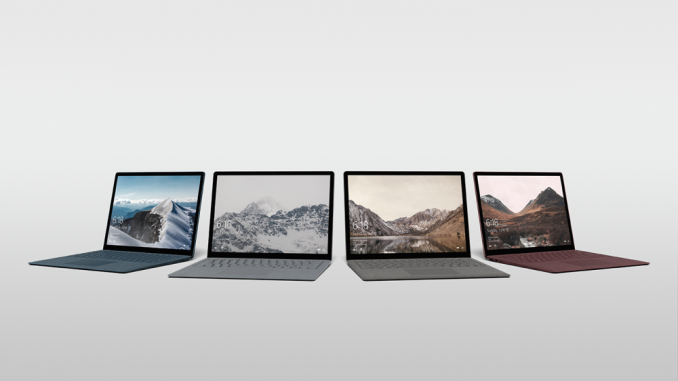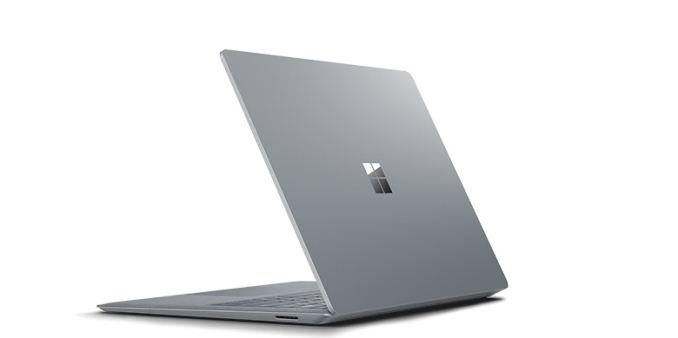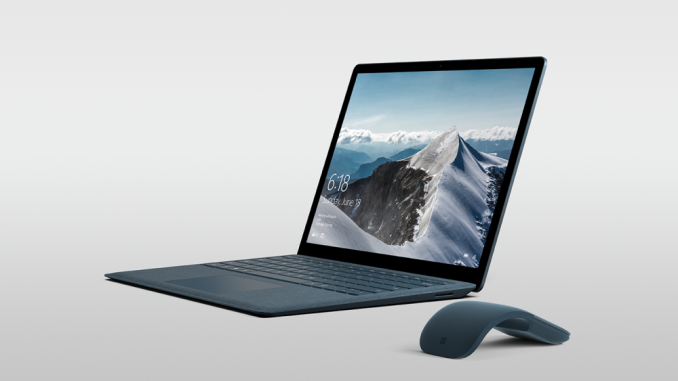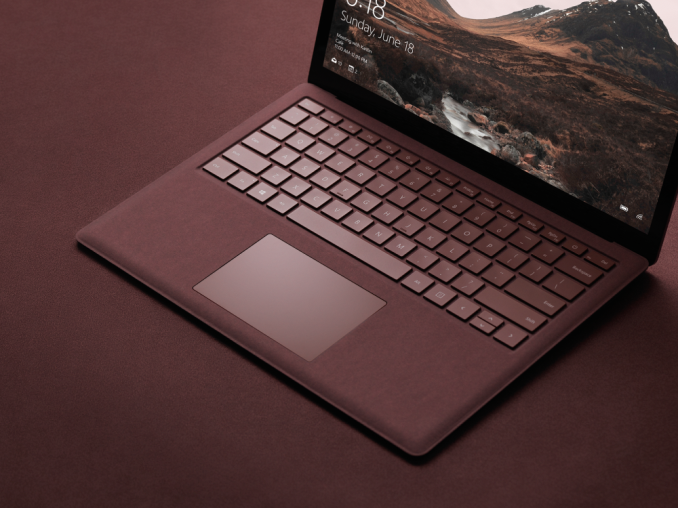Microsoft Announces The Surface Laptop
by Brett Howse on May 2, 2017 6:45 PM EST- Posted in
- Laptops
- Microsoft
- Surface
- Surface Laptop

In tech years, Surface has been around forever, but in actual Earth years, it’s been less than five years since Microsoft first put their toes into the PC hardware pool. The Surface lineup has always been about offering something unique on the computing landscape, with the Surface RT offering the first kickstand on a notebook, and the Surface Book offered a detachable GPU base. The quality of the products has improved very quickly over the last five years too, and with the Surface Studio, Microsoft is now offering one the best displays available to anyone in any device, and Surface Pro 4 is easily one of the best devices in its category (which it created).
But today they’ve taken a different turn. Today Microsoft is announcing the Surface Laptop. There’s no kickstand, no detachable display, no ability to fold it into a drafting table. There’s no fancy trick at all with the Surface Laptop. Microsoft just decided to finally build the one product that people were hoping they would build, and if it’s executed like most of their products, it should be a pretty strong offering compared to the competition. Although we were unable to attend the launch event in NYC today, let’s dig into what we do know about this to see how close they’ve come to the mark. With most of their products, they have tried to introduce a new category of computing, but with the Surface Laptop, there is an already large group of Ultrabooks to compete against.
| Microsoft Surface Laptop | |||||
| Processor | Intel Core i5-7200U 2C/4T 2.5-3.1 GHz 15W TDP Intel Core i7-7660U 2C/4T 2.5-4.0 GHz 64MB eDRAM 15W TDP |
||||
| Memory | 4 GB, 8 GB, 16 GB Dual-Channel LPDDR3-1866 | ||||
| Graphics | Intel Core i5-7200U Intel HD 620 (24 EUs, 300-1000 MHz) Intel Core i7-7660U Intel Iris Plus Graphics 640 (48 EUs, 64 MB eDRAM, 300-1100 MHz) |
||||
| Display | 13.5" 2256x1504 3:2 PixelSense Touch and Pen support 100% sRGB color, individually calibrated panels |
||||
| Storage | 128 GB, 256 GB, 512 GB, 1 TB PCIe NVMe | ||||
| Networking | Marvell AVASTAR Wireless-AC (802.11ac, 2x2:2, 866Mpbs Max, 2.4 and 5GHz) Bluetooth 4.0 |
||||
| Audio | OmniSonic stereo speakers with Dolby Audio Premium Dolby Audio |
||||
| Battery | 45Wh 44W A/C Adapter with 5 Watt USB port |
||||
| Right Side | Surface Connect Port (charging and docking) | ||||
| Left Side | USB 3.0 Full Size mini DisplayPort Headset Jack |
||||
| Dimensions | 308.02 x 223.2 x 9.93-14.47 mm (12.1 x 8.8 x 0.39-0.57 inches) | ||||
| Weight | 1.25 kg (2.76 lbs) | ||||
| Cameras | Front: 720p with Windows Hello support | ||||
| Pricing | 128 GB Intel Core i5 with 4GB of RAM: $999 256 GB Intel Core i5 with 8GB of RAM: $1299 256 GB Intel Core i7 with 8GB of RAM: $1599 512 GB Intel Core i7 with 16GB of RAM: $2199 |
||||
Starting with the display seems to be a great jump-off point, since Microsoft, more than any other OEM, has been pushing displays as a focal point, and it is again in the Surface Laptop. It features a 13.5-inch PixelSense display, in the now common aspect ratio for Surface of 3:2. Microsoft touts its devices as productivity machines, and the 3:2 aspect ratio helps a lot there. For those with good memories, the Surface Laptop’s display is the same size as the Surface Book, but it is not the same display. The display density is lower than both the Surface Pro 4 and Surface Book, which both feature 267 pixels per inch. Likely in an effort to lower costs, and increase battery life, Microsoft has chosen a 2256 x 1504 resolution for the Surface Laptop, which works out to 3.4 million pixels, and 201 pixels per inch. As with all Surface devices, the display supports 10-point multitouch, and it can be used with a Surface Pen. Microsoft also claims 100% sRGB coverage, with individually calibrated displays. They lead the industry here, and are one of the only PC makers that offer calibrated displays across all their devices now, with perhaps the exception of Apple. Despite the lowered resolution, the excellent aspect ratio and color calibration should still make this a solid display for day to day use.
Powering the Surface Laptop is an Intel Kaby Lake processor, with either the Core i5-7200U, or the Core i7-7660U. The Core i5 is along the same lines as what everyone is offering in an i5, but the Core i7 is a nice step up, featuring Intel’s Iris Plus Graphics 640. This is a handful of a name, this is the GT3e version of Intel’s latest integrated GPU, featuring twice the execution units of the normal HD 620, and it features 64 MB of eDRAM as well, so the overall processor should be faster for most tasks. It’s nice to see the Iris Plus available, as it is in the Surface Pro 4 i7 as well.
Memory starts at a mere 4 GB for the base model, but there will be 8 GB and 16 GB models as well. The Surface Laptop is leveraging LPDDR3 memory, so 16 GB will be the maximum. Storage is 128/256/512/1024 GB SSDs, as you’d expect in an Ultrabook.
One of the more interesting aspects of the Surface Laptop is the keyboard and trackpad. The trackpad is the same trackpad as the Surface Book, which is probably the best trackpad in the PC space right now, so that’s a good thing, and the Surface Book keyboard is also excellent, so expectations for the Surface Laptop are that it will match the Surface Book in these regards, however Microsoft has chosen to outfit the Surface Laptop with an Alcantara keyboard deck. This is a synthetic fabric, and they’ve used it before in a special edition version of the Surface Pro keyboard, as well as the Surface Ergonomic keyboard. Although it’s fabric, it is coated in a anti-spill coating, so liquids should bead off of it if it does get wet. It does have a great feel to it, assuming it’s similar to the other Surface products, so this should be a nice addition.
Like most Surface devices, it features a Windows Hello IR camera, allowing for facial recognition login, along with a 720p web cam. It would have been nice to see a 1080p camera here, but it should be adequate. The Surface Laptop also features a TPM 2.0 chip which should make it suitable for the enterprise. Microsoft is also showing off “OmniSonic” stereo speakers with Dolby Audio Premium, so in theory the sound quality should be ok, but with laptops the bar is always pretty low.
The one real omission on the Surface Laptop is in expandability. It features the SurfaceConnect port, for charging, just like the Surface Pro 4 and Surface Book, and Microsoft does sell a dock for this too. There is also a full-sized USB 3.0 port, and a mini DisplayPort. The one major omission is USB-C, which seems to be the port that Microsoft refuses to support. USB-C was around when they launched the Surface 3 back in April 2015, but they chose to charge it over micro USB, to its detriment. When they launched the Skylake powered Surface Pro 4 and Surface Book, USB-C and Thunderbolt 3 were available, but somewhat niche. In May 2017 though, USB-C should be on everything. The amazing thing is that they used the space for USB-C to offer a mini DisplayPort, when USB-C could do DisplayPort over its alternate modes. I have no problem with them keeping the SurfaceConnect port, but not offering USB-C at all, let alone Thunderbolt 3, seems like a missed opportunity. I agree the full sized USB 3.0 port is likely what most people would need right now, but a small bit of futureproofing with USB-C would not have killed them.
So that’s the hardware out of the way. Microsoft has been using Surface devices to push their software since Surface was first announced with Windows 8, and that hasn’t changed with the Surface Laptop. It will feature a new Windows version called Windows 10 S. We’ll get into Windows 10 S in another piece, but the basics are that it’s a version of Windows 10 which will only work with apps in the Windows Store. Sound familiar? Of course it does, since Windows RT had the same restriction. The difference between then and now is significant though. When Windows RT launched, the Store was an empty wasteland, and Microsoft never got the developer buy-in that they had hoped for. With Windows 10, the major difference is that Microsoft offers a Desktop bridge, allowing companies to bring their Win32 apps to the store relatively unmodified. So despite not being able to run apps from outside the Windows Store, you will still have access to Microsoft Office, and apps like Adobe Photoshop Elements. In many ways, the Store versions of these apps are superior to the legacy implementations, with much easier install and uninstall, and a more robust security model. But for those that need to install apps from outside the Windows Store, Windows 10 S can be unlocked to Windows 10 Pro, and on the Surface Laptop, that unlock will be free for the first year.
The new Surface Laptop is going to be available in four colors in the USA, with Platinum, Burgundy, Cobalt Blue, and Graphite Gold. Outside the USA, only one color will be offered initially, but the others should follow soon.
And then there is the price. Microsoft is being fairly competitive with the pricing, with the Surface Laptop starting at $999 USD for the base 4 GB / 128 GB / i5 model. That’s a strong starting price for a premium Ultrabook, although the RAM limitations will make it unappealing to many. For $1299, the i5 model bumps up to 8 GB of RAM and a 256 GB SSD, which is more in the sweet spot. The i7 model with Intel’s Iris Plus graphics starts at $1599 with the same 8 GB RAM and 256 GB SSD, and jumps to $2199 for the 16 GB / 512 GB model. Although the prices are high, the price comparisons to the competition are not that far off, meaning Microsoft likely didn’t make any friends with their OEMs today.
The new Surface Laptop is available for pre-order now, with shipments starting in June.














129 Comments
View All Comments
Alexvrb - Tuesday, May 2, 2017 - link
Free upgrade to Pro on the Surface Laptop. Right there in the article. They just want people to try Win S with it's fast boot and instant resume.Anyway, yes, the base model should have been 128GB SSD with 8GB of RAM. Not 4. That's my only gripe, outside of the pricing in general - but it's a premium-build flagship like all of the other high-end Surface devices. Not a surprise.
Devo2007 - Wednesday, May 3, 2017 - link
Well, the Surface Studio is a $2999 desktop with 8GB of RAM, so this isn't too surprising from Microsoft... Ha haSarah Terra - Tuesday, May 9, 2017 - link
I understand the temptation, I recently made the switch 3 years ago. I'll give u the speech I wish I could have given myself. There are a lot of base productivity flaws with OS X when you come from the MS ecosystem. A ton of things you take for granted every day in the windows world, are ass backwards or simply not there on OS X. Window management, folder creation, copying, overwriting, keyboard shortcuts. For instance you have the buy an app to overwrite and combine folders lol. There will be a significant adjustment period if you are a power user. Now, there are apps to address many of the shortcomings but they too come with their own glitches and it will take a lot of googling, configuring and App Store purchases to get things dialed in to where you can actually work as fast and multi task like you can in Windows. No touch screen either.Now for the hardware considerations. The latest MacBook Pro is absurdly priced, the Mac mini is slow, and Mac Pro is ancient and slow and even more absurdly priced. Probably the Best Buy is the iMac, but it isn't portable. SInce jobs has died, Apple has slid downhill significantly. OS Upgrades have been bug ridden, and clearly a regression towards consumers vs professionals. It seems every version they take something away from developers and add more IOS features. Little things like forcing you to visitthe Mac store before allowing updates. iTunes is a core OS component, its rediculous. The prices go up and up. Be prepared for 30-100 dollar dongles, and dongles all over your desk. no more cheap amazon versions. Buying cheap Apple cables just don't work, or only work for short periods. You wind up having to pay for quality cables, particularly if you wish to use a 3rd party display.
As of now, I tempted to go back to windows. It would be a painful switch, but having access to the latest hardware at same prices is just getting harder to ignore when Apple keeps doing minor iterations, jacking prices and making decisions like taking away my headphone jack and magport and escape key.
If Apple prices came down 35 percent I'd say the switch would be perhaps worth it, but as of now I'd say stick to windows, and I'll likely be coming back soon. I refuse to buy the new MacBook, it is a downgrade in many respects and costs almost 1000 more than previous version. Absurd. MS will eventually get it right and you will always have better hardware at better prices than in the Apple ecosystem.
Though if they are heading towards the Apple way of doing things they could start holding users at hostage pricing premiums there too, a frightening thought.
ComeOnNow - Wednesday, May 17, 2017 - link
LOL, All MSFT has ever done is 'ape Apple's strategy'. Badly. (Heck, they inserted Apple's freaking SOURCE CODE in 'Windoze Media')DanNeely - Tuesday, May 2, 2017 - link
When did 200 DPI become low res?lilmoe - Tuesday, May 2, 2017 - link
It should be pretty darn apparent for all of you, by looking at the latest products targeting this particular segment of the market, that specs mean nothing. Design, brand and overall and the overall package is everything. Consumers of this segment worry more about the keyboard, screen, light weight, colors and simplicity (clean design) of the device. If you nail all of these, then you're golden.If they went with better specs, then it's going to create more confusion for the intended market. This is for the consumer that doesn't want all the bells and whistles of previous Service offerings.
Would I buy one? Heck no. Does it appeal to me? Not in the slightest. Would it my wife want one for her home office? Most probably yes.
Alexvrb - Tuesday, May 2, 2017 - link
You nailed it. They're not going after spec hounds, techies, or gamers. I sure as heck wouldn't spend that kind of coin on something so mild. But I know I'm not the target audience, and I can respect the reasons someone might want one, to a degree. They are really premium devices, I can see a lot of business users wanting one.Meteor2 - Wednesday, May 3, 2017 - link
Good point well made. But I think most people in that category would pick a Mac -- and rightly so. If you're going to pay a premium for form over function, may as well get a good device.twtech - Thursday, May 11, 2017 - link
One thing that I think is easily overlooked when looking at specs in the laptop space is that the input devices, etc., matter quite a bit.Comparing to desktop computers where it really doesn't matter what the system might come with because you can easily replace your input devices and monitor at will, I think it's easy to have a perspective that discounts the importance of these things when looking at laptops.
With a laptop, you're stuck with the keyboard, trackpad, screen for the life of the device. If MS has done a really good job in these areas, then that counts for something beyond raw specs.
sc14s - Wednesday, May 3, 2017 - link
"low res", lolI think I found the MS hater. "OMG ITS NOT 8k PANEL WTF"